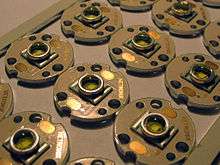Cree Inc.
 | |
| Public | |
| Traded as | |
| Industry | Electronics |
| Founded | 1987 |
| Headquarters | Research Triangle Park, North Carolina, United States |
| Products | Light-emitting diodes |
| Revenue | $1.65 billion[1] |
| USD $124 million (Fiscal Year 2014)[1] | |
Number of employees | 6,387[2] |
| Website |
cree |
Cree, Inc. is an American worldwide manufacturer and marketer of lighting-class LEDs, lighting products and products for power and radio frequency (RF) applications. Most of its products are based on silicon carbide (SiC), a rare, naturally occurring mineral compound which early Cree researchers successfully synthesized in a laboratory. SiC enables higher performance in applications which require high endurance and in semiconductor devices that operate at high temperatures or high voltages, or both.[2] With the establishment of a reliable source for high-quality SiC, the firm expanded into several market segments with products that provided significantly higher performance and efficiency.[2] Cree's product families include LED lighting systems and bulbs, blue and green LED chips, high-brightness LEDs, lighting-class power LEDs, and a portfolio of SiC-based and wide bandgap SiC-on-GaN (gallium nitride) power-switching and RF (radio frequency) devices. These products enable applications that include general illumination, electronic signs and signals, industrial power supplies and inverters, and military, satellite and broadband telecommunications.
History


Cree was founded in July 1987 in Durham, North Carolina. Five of the six founders – Thomas Coleman, John Edmond, Eric Hunter, John Palmour and Calvin Carter – are graduates of North Carolina State University.[3]
In 1983, the founders – one a research assistant professor and the others student researchers – were seeking ways to leverage the properties of silicon carbide to enable semiconductors to operate at higher operating temperatures and power levels.[3] They also knew silicon carbide could serve as the diode in light-emitting diode (LED) lighting, a light source first demonstrated in 1907 with an electrically-charged diode of SiC.
The research team devised a way to grow silicon crystals in the laboratory, and in 1987 founded a company, Cree Research, Inc., to produce SiC and exploit its usage commercially in both semiconductors and lighting. The founders raised money to establish office and laboratory facilities and entered a period of steady technological advancements.[3]
In 1989, the company introduced the world's first blue LED, which enabled the development of large, full-color video screens and billboards.[3]
In 1991, Cree released the world's first commercial silicon carbide wafer.[3]
In 1993, Cree launched an initial public offering.
In 1999, the company name is changed from Cree Research to Cree, Inc.[4]
In 2011 Cree acquired Ruud Lighting, a national firm experienced in the use of LED for outdoor lighting. This expanded Cree sales channels and led to a new generation of lighting-class LED components.[5]
In 2012 Cree announced the XLamp XT-E, which was claimed to deliver twice as much light for the same price as older LEDs.[6]
In 2013, Cree's first consumer products, two household LED bulbs qualified for Energy Star rating by the United States Environmental Protection Agency.[7]
In July 2016, German chip maker Infineon Technologies AG said it agreed to buy Cree's Wolfspeed business unit (RF and power electronics devices) for $850 million in cash.[8] However, the deal was called off in February 2017 after the companies were unable to resolve regulators’ national security concerns.[9]
In March 2018, Cree announced the acquisition of Infineon Technologies AG's RF Power Business for €345 Million.[10]
See also
References
- 1 2 Garrabrant, Raiford (2015-05-05). "Cree Reports Financial Results for the Fourth Quarter and Fiscal Year 2014" (PDF). Cree.
- 1 2 3 "2015 Annual Report" (PDF). Annual reports. Cree. Retrieved 2016-05-27.
- 1 2 3 4 5 "Creating CREE". NC State Engineering Magazine (Spring 2010). 2010. Retrieved 2016-05-27.
- ↑ "Cree proposes a public offering, changes name". Triangle Business Journal. Raleigh, NC: American City Business Journals. 2000-01-03. Retrieved 2016-05-27.
- ↑ Wright, Maury (2011-08-01). "Cree acquires lighting manufacturer Ruud and BetaLED subsidiary". LEDs Magazine. Retrieved 2016-05-27.
- ↑ Ranii, David (2012-02-08). "Cree launches another lower-cost LED". The News & Observer. Archived from the original on April 4, 2012. Retrieved 2012-02-08.
- ↑ Funk, John (October 10, 2013). "Cree's LED bulb now Energy Star, qualifies for up to $5 price cut". The (Cleveland) Plain Dealer. Retrieved 2013-10-10.
- ↑ By Friedrich Geiger and Eyk Henning, Wall Street Journal. "Infineon to Buy Cree's Wolfspeed Unit for $850 Million ." July 14, 2016.
- ↑ Armental, Maria (2017-02-16). "Cree and Infineon Call Off Wolfspeed Deal". WSJ. Retrieved 2017-06-08.
- ↑ "Cree Acquires Infineon's RF Business for €345 Million". everything RF.
External links
- Official website
- Gereffi, Gary; Ahmed, Ghada; Lowe, Marcy (Oct 22, 2010). "Case Study: Cree, Inc. Local Markets and Global Competitiveness: A Value Chain Analysis" (pdf). Center on Globization, Governance, & Competitiveness (CGGC). Duke University.